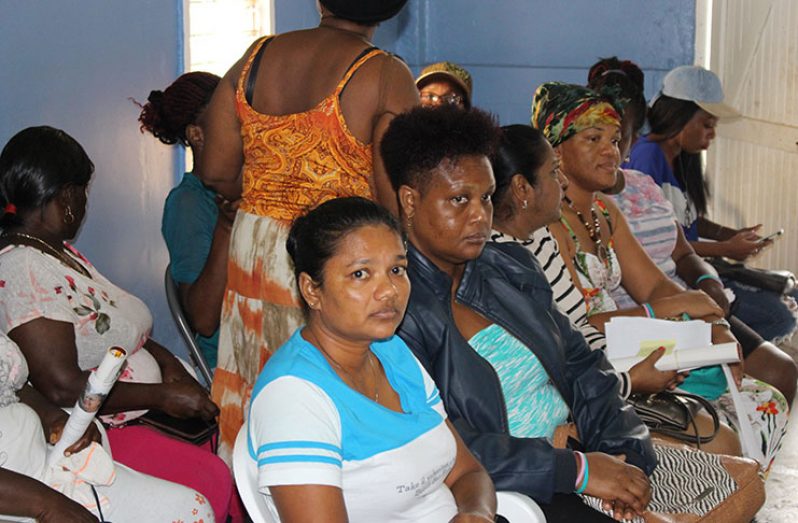– early screening could save lives
DR LATOYA Gooding, President and Founder of the Giving Hope Foundation is continuing in her fight to save lives, especially those with cervical and other cancers. Through her foundation, she has been offering various forms of free medical services to members of the public. At the same time, she has been advancing the view that early screening and detection save lives.
DemBake Medical Outreach
On Saturday February 10, Demerara Bakery, in collaboration with the Giving Hope Foundation – Guyana, HEROC and the Ministry of Public Health, hosted a free cancer screening outreach at the Bakery’s Block G1,Land of Canaan, East Bank Demerara location, at the same time reaching out to surrounding communities on the East Bank.
The exercise was aimed at giving back to the community, especially to those living on the East Bank. According to Dr Gooding, the Demerara Bakery was more than happy to facilitate the team of doctors, nurses and volunteers as they provided services such as free pap smears, VIA, breast and prostate examinations, as well as free blood pressure and blood sugar tests.

The outreach saw more than 100 men and women turn out to take advantage of the free screening exercise, acknowledging the fact that early detection could save their lives.
Many were thankful that such a project was done on the East Bank and were especially grateful to Demerara Bakery for taking a lead in it. They were also ecstatic that not only did the bakery provide some of the best products in the country, but they also had the public’s health in mind.
GIVING HOPE STRESSES EARLY SCREENING
Founder of the Giving Hope Foundation, Dr. Latoya Gooding was present at the event and reiterated the importance of early screening as many cases of cancer-related deaths in Guyana occur because of late-stage diagnosis. She was also happy about the collaboration with DemBake and expressed her anticipation for future collaboration with the company.
Dr. Gooding, who is a practising medical doctor, is of the view that one case of cervical cancer is one too many. She is concerned about the fact that this form of cancer is the second leading cancer among women in this part of the world – accounting for the majority of cancer deaths among women here.
Studies have shown that women need not die from cervical cancer since early testing and detection can facilitate successful eradication of the disease.
THE GROWTH OF CERVICAL CANCER
Cancer of any sort is said to start when cells in the body begin to grow out of control since cells in almost any part of the body can become cancer, spreading to other parts of the body. Cervical cancer, also known as cancer of the cervix is no exception. It starts in the cell lining of the cervix – the cervix connects the body of the uterus to the vagina or birth canal.
Research has shown that the cervix has two different parts and is covered with two different types of cells. The part of the cervix closest to the body of the uterus is called the endocervix and is covered with glandular cells; The part next to the vagina is the exocervix (or ectocervix) and is covered in squamous cells.
These two cell types meet at a place called the transformation zone. The exact location of the transformation zone changes as you get older and if you give birth.
Studies also indicate that most cervical cancers begin in the cells in the transformation zone. These cells do not suddenly change into cancer. Instead, the normal cells of the cervix first gradually develop pre-cancerous changes that turn into cancer. These changes can be detected by the Pap test and treated to prevent cancer from developing – a condition Dr. Gooding has been persistently advocating for.
Studies have assured that although cervical cancers start from cells with pre-cancerous changes (pre-cancers), only some of the women with pre-cancers of the cervix will develop cancer. It usually takes several years for cervical pre-cancer to change to cervical cancer, but it also can happen in less than a year. For most women, pre-cancerous cells will go away without any treatment. Still, in some women pre-cancers turn into true (invasive) cancers. Treating all cervical pre-cancers can prevent almost all cervical cancers.
CANCER SURVEILLANCE REPORT
The Cancer Surveillance Report of 2015, which was conducted by Dr, Morris Edwards has shown that the cumulative incidence rate [CIR] of cervical cancer during the reporting period – 2003 – 2012 was 270 per 100,000 populations; the recorded state of cancer was just over 1,000 reported cases of cervical cancer back then.
Dr. Gooding, who has a wealth of experience in this field of study, is of the view that Afro and Indo Guyanese women continue to account for the majority of cervical cancer cases, but that no woman, regardless of race is exempt from cervical cancer.
Giving Hope Foundation plans to continue moving across the length and breadth of Guyana giving hope to all women who would make themselves available to receive advice and attention. (mercilinburke2017@gmail.com)




.png)









